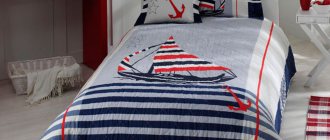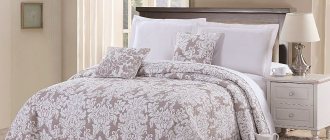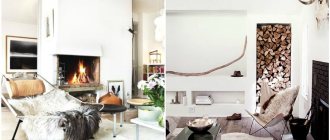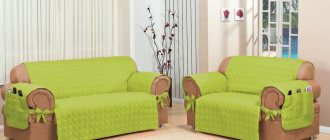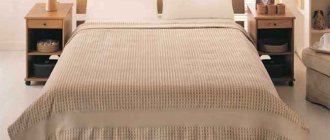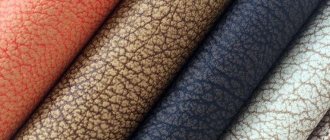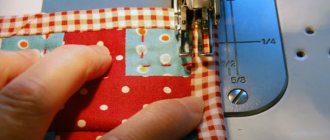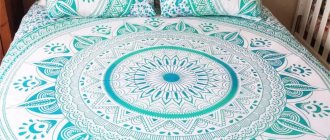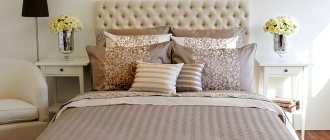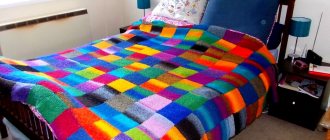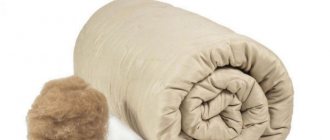When arranging a bedroom, most people pay special attention to the furniture and decoration of the room, while forgetting that the main functional part of this room is the bed. Good pillows, a lush blanket, beautiful and high-quality bed linen - all this plays a major role in the comfort and coziness of the bedroom. Well, the finishing touch - the bedspread - will not only help to place accents in the interior of the room, but will also ensure the cleanliness of your sleeping area.
And if everything is more or less clear with the choice of fabric and color of the bedspread, then deciding on its size can be quite difficult - here you need to take into account some nuances that many simply do not pay attention to. To ensure that your bed always looks neat and beautiful, we have prepared the material “How to choose the size of a bedspread?” – perhaps some of the tips collected in it will help you.
Choosing the size of a bedspread requires precision and care - after all, a sloppily made bed spoils the look of even the most modern and stylish bedroom.
How to correctly determine the size of a bedspread?
Before choosing a bedspread size, you must first take measurements of your mattress. Today, manufacturers offer mattresses of various widths (from 80 to 200 cm), lengths (190, 195 or 200 cm) and heights (from 15 to 32 cm).
The easiest way to choose a bedspread size is to use standard formulas:
- Bedspread width = mattress height*2 + mattress width.
- Bedspread length (for a bed without a footrest) = mattress height + mattress length.
- Bedspread length (for a bed with a footrest) = mattress length.
For example, your mattress has standard dimensions of 160*200 cm, height - 20 cm. Your bed does not have a footrest. Choose the bedspread size as follows:
- Width = 20*2+160 = 200 cm
- Length = 20+200 = 220 cm
In this case, a 200*220 bedspread is perfect - it will completely cover the mattress, thereby protecting the bed from dust and making the bed neat and well-groomed.
For cribs, the bedspread must be chosen according to the size of the upper plane of the mattress (standard - 60*120 or 65*125 cm), since it is surrounded on all sides by sides.
When choosing a bedspread, the rule “more is not better” applies. A bedspread that is too large will dangle on the floor, spoiling the appearance of the room. And in terms of cleanliness, this is not very good - dust from the floor will fall on the bed.
Variations of the classic version
If you choose a bedspread with a margin of length (taking into account the necessary allowance and an additional addition of 30-60 cm), then you can carefully and flirtatiously roll up part of the bedspread at the head of the bed.
You can roll the bedspread in various ways (straight fold, accordion fold, roll).
It's very easy to make a decorative fold along with the blanket. To do this, cover the bed with a blanket so that it falls evenly along the edges. Next, near the headboard, you need to bend the top edge of the bedspread along with the blanket by about one third. Fold the free edge of the bedspread inward.
A bed with a double-sided bedspread, for example, like models from the brands Arya, Valtery, Love You, will look very original.
Standard bedspread sizes
For your convenience, we have compiled a table of mattress sizes corresponding to bedspread parameters. Please note that we took the average height of the mattress - 20 cm.
| Mattress size | Bedspread size for bed with foot back (width*length) | Size of bedspread for a bed without a backrest (width*length) |
| 80*200 or 90*200 cm (single) | 120*200 or 130/150*200 cm | 120*220 or 140/150*220 cm |
| 120*200 cm (one and a half) | 160*200 cm | 160*220 cm |
| 140*200 cm (double Russian standard) | 180*200 cm | 180*220 cm |
| 160*200 cm (double euro standard) | 200*200 cm | 200*220 cm |
| 180*200 cm | 220*200 cm | 220*220 cm |
| 200*200 cm | 240*200 cm | 240*220 cm |
If you prefer the cover to fall lower than the mattress, add 10-20cm to the width.
As for children's beds, keep in mind that most often the long side is against the wall, so the bedspread should not be much wider than the mattress:
| Mattress size | Bedspread size for bed with foot back (width*length) |
| Cribs for newborns – 60*120 or 65*125 cm | 60*120 or 65*125 cm |
| Beds for preschool children – 60*140 cm, 60*160 cm, 70*160 cm | 80/100*140 cm, 80/100*160 cm, 90/100*160 cm |
| Beds for schoolchildren – 80*160 cm, 80*180 cm, 80*195 cm | 100*160 cm, 100*180 cm, 100*195/200 cm |
There are bedspreads with lambrequins. The lambrequin can be sewn on two sides (for beds with a footboard) or on three sides (for beds without a footboard). Measure the area of the upper surface of the mattress - it will be equal to the size of the bedspread (for example, 160*200 cm). The length of the lambrequin should not exceed the height of the bed with mattress.
Often in photos of interiors you can see bedspreads beautifully spreading across the floor. It is worth noting that this solution is not practical for daily use and is most often used only for advertising purposes - in everyday life, a bedspread that is too long will cause you a lot of problems when cleaning, in addition, you will constantly step on it when passing by the bed.
Today, manufacturers offer not only a huge selection of fabrics and colors, but also bedspread sizes, so you can be sure that you can easily find an option that suits you.
Blankets and bedspreads for your comfort
Best prices for bulk purchases
View in the catalog
Tips for choosing a bedspread
If you have definitely decided on the size, you should think about ensuring that the purchased bedspread fits harmoniously into the design of the room:
- Color.
It should be in harmony with the overall style of the bedroom. This does not mean at all that if the wallpaper is beige, then the bedspread should be the same. On the contrary, completely monochromatic interiors have long gone out of fashion. Now designers offer brighter and bolder solutions based on a combination of several colors (usually no more than 3-4, but each can be presented in 1 or 2 shades). For example, dark blue carpeting, gray furniture, a cherry-colored bedspread and additional white inclusions in the form of accessories (lamps, figurines, boxes for storing small items, etc.). Or walnut flooring, walls in shades of blue, white furniture and a gray bedspread, and for contrast, you can throw a few blue throw pillows on the bed. - Textile.
Today you can find a variety of options on sale - from cheap and practical microfiber and fleece to expensive and luxury materials such as silk or tapestry.
For children's beds, you need to choose durable fabrics that are easy to wash (after all, taking a bedspread to the dry cleaner once a week is not very convenient, and also expensive). In a bedroom for adults, you should choose the material of the bedspread based on the features of the interior - a luxurious jaccrad bedspread will look ridiculous in a room with a restrained interior in the loft or hi-tech style. And vice versa - for a bedroom in a classic style it is better to choose a satin bedspread with a lambrequin. Fleece and microfiber.
The most practical fabrics. Ideal for children's beds. They are easy to wash in a regular washing machine, they do not shrink, dry very quickly and do not lose their appearance even after numerous washes. - Cotton.
“Waffle” bedspreads have become fashionable. They look original and are perfect for bedrooms designed in a minimalist style. They hold up well to washing and retain their original appearance for a long time. - Satin.
Eco-friendly material that does not require special care. If you have a cat at home, a satin bedspread will be an excellent option - thanks to the special weave of the threads, the surface of the fabric is smooth, so the fur does not stick to it. All you have to do is shake out such a bedspread thoroughly - and now it’s as good as new. - Linen.
Natural materials are now at the peak of popularity. Linen bedspreads are beautiful, durable, do not absorb odors, and are not afraid of machine washing. The only negative is that they are quite difficult to iron (you need to either not completely dry it before ironing, or use a powerful steamer). - Jacquard.
A beautiful fabric that belongs in luxurious bedrooms. Most often, these bedspreads are quilted - this adds a special chic to them. - Tapestry.
Expensive fabric, but it is very durable. Such a bedspread will last for many years and, with proper care, will not lose its original qualities. - Artificial fur.
It looks stylish and original. A fluffy blanket will fit into almost any interior, but it has an obvious drawback - this material is easily electrified. - Silk.
Silk is considered one of the best fabrics for bed linen, including bedspreads. It perfectly absorbs moisture, “breathes”, and a huge number of colors and tailoring options will allow you to choose the perfect silk bedspread for any bedroom. Disadvantages - high price.
Don't lose sight of the fact that the bedspread should match the color and texture of the window curtains.
It is also worth considering the color of the bed linen - ideally, the bedspread should match the shade of the duvet cover and pillowcases.
Material of manufacture
All existing types of bedspreads for a double bed can be divided into several groups. Each represents a different type of material used for production. The table shows the features and characteristics of each fabric.
| Subspecies | pros | Minuses |
| Cotton | Availability, high hygroscopicity, practicality, safety, ease of care | Wrinkles heavily and wears out quickly |
| Silk | Pleasant to the touch, breathable, has excellent aesthetic properties | High price, difficult care |
| Linen | UV resistant, durable. Does not accumulate static, hypoallergenic | Wrinkles quickly and may shrink in size when washed. |
| Wool | Has good thermal conductivity, ideal for the cold season | Do not treat with hot steam, do not machine wash |
| Fleece | Characterized by light weight, a variety of colors, and softness | Accumulates static, so it is not always comfortable to touch the material |
| Artificial fur | Unlike natural material, this raw material has a lower price. Bedspreads made from it are easy to clean and look authentic | Often ingredients that are unsafe for health are added to the composition. |
| Polyester | Durable, wear-resistant, lightweight, does not deform during use | High density helps retain heat, so in the summer such a blanket will be irrelevant |
| Knitted products | They look beautiful and unusual, you can make them yourself | May tingle the skin |
The stores offer beautiful styles of bedspreads for a double bed: woolen, plain fleece, knitted, patchwork. For the bedroom, it is recommended to choose capes made of natural materials, for example, wool, cotton, linen. But if attractive appearance and low cost are your priority, then you can choose options made from polyester or fleece.
Soft fleece
Knitted
Original patchwork
Faux fur
Woolen
Natural cotton
How to care for a bedspread?
The main purpose of the bedspread is to protect the bed from dust and small debris. Thus, you will have to wash this household item quite often. Some types of fabrics are not intended for machine and hand washing; in addition, bulky bedspreads made of thick material simply will not fit even in a washing machine with a large load of laundry - they need to be taken to the dry cleaner regularly.
Care rules common to all types of bedspreads:
- Do not overload the washing machine - if you plan to wash the bedspreads, then leave other items (even if they easily fit in the drum) for the next load.
- Strictly observe the dosage of detergents. If there are stains on the bedspread, you can pour a stain remover for delicate fabrics onto them before washing (it is better not to use bleach).
- Try to use liquid and gel products (they dissolve better even in cold water and are easier to rinse).
- To give the product additional freshness and softness, use fabric softeners. By the way, this will also make ironing easier for you.
- Sort your bedspreads by fabric type and color - don't wash white cotton with colored silk.
Otherwise, the rules for caring for different species covered the following:
- Fleece and microfiber.
You can wash at temperatures from 30 to 60 degrees, depending on the degree of contamination. Don't be afraid that the bedspread will lose color or shrink - after drying it will be like new. You cannot iron fleece and microfiber (especially since this is not necessary - the products do not wrinkle). - Cotton.
100% cotton can be washed even at high temperatures – up to 95%. But take into account the fact that natural fabrics shrink - the higher the temperature, the “smaller” your bedspread will become. Also keep in mind that it is better not to boil colored bedspreads - they may fade. White cotton items can be bleached. You can iron cotton without risk of damaging the product. - Satin.
Satin fabric is made from cotton threads, so it can withstand washing at 60 degrees. Spin – 800 rpm (then the product will be easy to iron). Satin should be ironed at medium heat. - Jacquard.
This type of blanket requires special care. Most likely, it will not fit in a standard machine with a 5-kg load, so to get rid of household stains, you will have to take it to the dry cleaner. The complex structure of the fabric does not favor ironing. To keep the bedspread clean and fresh longer, you can clean it from time to time with a soft brush and wipe with a damp sponge. It is better to hide jacquard products from direct sunlight. - Tapestry.
As in the case of jacquard, due to the large volume and density of the bedspread, it is difficult to “squeeze” it into the drum of a washing machine. However, if the item is made of 100% cotton, it can be washed by hand in warm water and using liquid detergent (powdered detergents are more difficult to rinse out). It is better to iron from the inside out or through gauze fabric from the front side. Tapestry bedspreads do not deform when washed, do not fade or lose color when washed. If the fabric contains synthetic impurities, then gentle washing at low temperatures is recommended, ironing is not allowed (it is advisable to shake the wet product well and hang it without folds or creases). - Artificial fur.
Wash - at a temperature of 30-40 degrees in a gentle cycle. Spin – 400-600 rpm. To prevent fur from matting, use special detergents for washing delicate fabrics. After washing and drying (preferably in the fresh air), the bedspread should be shaken thoroughly and, if necessary, combed with a fine-bristled brush. Naturally, such products do not need ironing. - Silk.
Machine washing is not recommended - only hand washing in a very gentle cycle. You can’t twist the silk too much - just squeeze it lightly and let the rest of the water drain on its own. Iron at a moderate temperature and only on the wrong side (it is advisable that the bedspread is slightly damp).
When buying a bedspread, pay attention to the label - manufacturers always indicate the type of fabric, care instructions and care instructions for the product. Satin made from 100% cotton and with synthetic admixtures will require completely different care.
